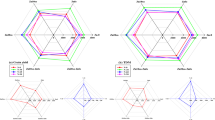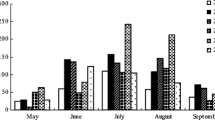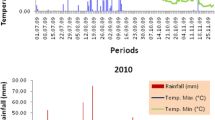Abstract
Nitrogen (N) losses from the N sources such as manures, fertilizers etc. applied to crops are considered as the largest non-point source of nitrogen-nitrate pollution in surface and groundwater bodies. The extent of water bodies polluted with N is worsening day by day, worldwide, with its severe impact on the quality of drinking water. This necessitates the development of crop specific N management practices to reduce N losses from crop systems. Improvements in agronomic and recovery efficiency of nitrogen in crops are regarded as promising techniques to reduce N losses. With the hypothesis that precise N supply in maize employing LCC or CCM under a critical threshold value will augment the yield performances and Nitrogen Use Efficiency (AEN and REN) of maize, while reducing N losses, a two year study was conducted at Anand, India. Fifty percent reduction in basal N application and subsequent N applications based on LCC critical value 5 resulted in 12.30 and 12.25% increment in maize grain yield over recommended practices during the year 2015 and 2016, respectively. Significant improvement for total biological yield, grain protein accumulation in maize and total N uptake by crop was observed in the direction of N application using LCC threshold point 5, CCM threshold point 40 and recommended practice. Applying nitrogen at whatever the times LCC critical point drops ≤ 5 also recorded 4.09 and 4.17 kg gain in grain produced (over recommended practice) kg−1 of N supplied (AEN), 0.16 and 0.17 kg gain in N uptake (over recommended practice) kg−1 of N supplied (REN) during 2015 and 2016, respectively and a total reduction of 51.14 kg N loss ha−1 (over recommended practice) for the entire study period. The study reveal that compared to blanket application, N fertilizers can be more efficiently managed with LCC threshold value 5 or CCM threshold value 40 for guiding N application with higher yield, NUE and reduced N losses in maize crop.









Similar content being viewed by others
Abbreviations
- @:
-
At the rate of
- AEN :
-
Agronomic efficiency of nitrogen
- ANOVA:
-
Analysis of variance
- BSS:
-
Bright sunshine hours
- CCI:
-
Chlorophyll content index
- CCM:
-
Chlorophyll content meter
- DAP:
-
Days after planting
- DAS:
-
Days after sowing
- EC:
-
Electrical conductivity
- g:
-
Gram
- GAYMH:
-
Gujarat Anand yellow maize hybrid
- ha− 1 :
-
Per hectare
- K:
-
Potassium
- kg:
-
Kilogram
- kg ha− 1 :
-
Kilogram per hectare
- L:
-
Litres
- LCC:
-
Leaf color chart
- LSD:
-
Least significant difference
- m:
-
Meter
- m2 :
-
Meter square
- mg:
-
Miligram
- MMRS:
-
Main maize research station
- N:
-
Nitrogen
- NUE:
-
Nitrogen use efficiency
- OC:
-
Organic carbon
- P:
-
Phosphorus
- PC:
-
Principal component
- PCA:
-
Principal component analysis
- PFPN:
-
Partial factor productivity for nitrogen
- RDN:
-
Recommended dose of nitrogen
- REN :
-
Recovery efficiency of nitrogen
- RF:
-
Rainfall
- RH:
-
Relative humidity
- SPAD:
-
Soil plant analysis development
- t:
-
Tons
References
Ahmad, N., Zada, A., Junaid, M., & Ali, A. (2016). Bridging the yield gap in rice production by using leaf color chart for nitrogen management. Journal of Botany. https://doi.org/10.1155/2016/2728391.
Asibi, A. E., Chai, Q., & Coulter, A. J. (2019). Mechanisms of nitrogen use in maize. Agronomy, 9(12), 775.
Baligar, V. C., Fageria, N. K., & He, Z. L. (2001). Nutrient use efficiency in plants. Communications in Soil Science and Plant Analysis, 32(7–8), 921–950.
Barak, P., Jobe, B. O., Krueger, A. R., Peterson, L. A., & Laird, D. A. (1997). Effects of long-term soil acidification due to nitrogen fertilizer inputs in Wisconsin. Plant and Soil, 197(1), 61–69.
Bhat, T. A., Ahmad, L., & Kotru, R. (2015). Relation between agrometeorological indices, crop phenology and yield of rice genotypes as influenced by real time N management. Journal of Agrometeorology, 17(1), 90.
Binder, D. L., Sander, D. H., & Walters, D. T. (2000). Maize response to time of nitrogen application as affected by level of nitrogen deficiency. Agronomy Journal, 92(6), 1228–1236.
Bouwman, A. F., Boumans, L. J. M., & Batjes, N. H. (2002). Emissions of N2O and NO from fertilized fields: Summary of available measurement data. Global Biogeochemical Cycles, 16(4), 1–6.
Bullock, D. G., & Anderson, D. S. (1998). Evaluation of the Minolta SPAD-502 chlorophyll meter for nitrogen management in corn. Journal of Plant Nutrition, 21(4), 741–755.
Cassman, K. G. (1999). Ecological intensification of cereal production systems: Yield potential, soil quality, and precision agriculture. Proceedings of the National Academy of Sciences, 96(11), 5952–5959.
CDPH (2013). California Department of Public Health. Retrieved from Drinking water contaminants: Nitrate. http://www.ehib.org/page.jsp?page_key=14. Accessed 20 Dec 2019.
Chen, Y., Xiao, C., Wu, D., Xia, T., Chen, Q., Chen, F., et al. (2015). Effects of nitrogen application rate on grain yield and grain nitrogen concentration in two maize hybrids with contrasting nitrogen remobilization efficiency. European Journal of Agronomy, 62, 79–89.
Christianson, L. E., & Harmel, R. D. (2015). 4R Water quality impacts: An assessment and synthesis of forty years of drainage nitrogen losses. Journal of Environmental Quality, 44(6), 1852–1860.
Clements, H. F. (1964). Interaction of factors affecting yield. Annual Review of Plant Physiology, 15(1), 409–442.
De Vita, P., Di Paolo, E., Fecondo, G., Di Fonzo, N., & Pisante, M. (2007). No-tillage and conventional tillage effects on durum wheat yield, grain quality and soil moisture content in southern Italy. Soil and Tillage Research, 92(1–2), 69–78.
Dobermann, A., & Cassman, K. G. (2005). Cereal area and nitrogen use efficiency are drivers of future nitrogen fertilizer consumption. Science in China Series C: Life Sciences, 48(2), 745–758.
Dobermann, A., Witt, C., Abdulrachman, S., Gines, H. C., Nagarajan, R., Son, T. T., et al. (2003). Soil fertility and indigenous nutrient supply in irrigated rice domains of Asia. Agronomy Journal, 95(4), 913–923.
Dobermann, A., Witt, C., Dawe, D., Abdulrachman, S., Gines, H. C., Nagarajan, R., et al. (2002). Site-specific nutrient management for intensive rice cropping systems in Asia. Field Crops Research, 74(1), 37–66.
Fageria, N. K., & Baligar, V. C. (2005). Enhancing nitrogen use efficiency in crop plants. Advances in Aronomy, 88, 97–185.
FAO (2006). Fertilizer use by crop. FAO fertilizer and plant nutrition bulletin 17. Food and Agriculture Organization of the United Nations Rome, pp 60–62.
Fuertes-Mendizábal, T., González-Torralba, J., Arregui, L. M., González-Murua, C., González-Moro, M. B., & Estavillo, J. M. (2013). Ammonium as sole N source improves grain quality in wheat. Journal of the Science of Food and Agriculture, 93(9), 2162–2171.
Furuya, S. (1987). Growth diagnosis of rice plants by means of leaf color. Japan Agricultural Research Quarterly, 20, 147–153.
Gomez, K. A., & Gomez, A. A. (1984). Statistical procedures for agricultural research. New York: Wiley.
Gong, L., Huo, M., Yang, Q., Li, J., Ma, B., Zhu, R., et al. (2013). Performance of heterotrophic partial denitrification under feast-famine condition of electron donor: A case study using acetate as external carbon source. Bioresource Technology, 133, 263–269.
Gupta, A. P. (2005). Nitrogen use scenario in India. Science in China Series C: Life Sciences, 48(2), 921–927.
Gupta, R. K., Singh, V., Singh, Y., Singh, B., Thind, H. S., Kumar, A., & Vashistha, M. (2011). Need-based fertilizer nitrogen management using leaf colour chart in hybrid rice (Oryza sativa). Indian Journal of Agricultural Sciences, 81(12), 1153.
Hasan, M. N., Khaliq, Q. A., Mia, M. A. B., Bari, M. N., & Islam, M. R. (2016). Chlorophyll meter-based dynamic nitrogen management in wheat (Triticum aestivum L.) under subtropical environment. Current Agriculture Research Journal, 4(1), 54–61.
Helmers, M. J., Zhou, X., Baker, J. L., Melvin, S. W., & Lemke, D. W. (2012). Nitrogen loss on tile-drained Mollisols as affected by nitrogen application rate under continuous corn and corn-soybean rotation systems. Canadian Journal of Soil Science, 92(3), 493–499.
Hirel, B., Le Gouis, J., Ney, B., & Gallais, A. (2007). The challenge of improving nitrogen use efficiency in crop plants: Towards a more central role for genetic variability and quantitative genetics within integrated approaches. Journal of Experimental Botany, 58(9), 2369–2387.
IPI (1980). Physiological aspects of crop productivity. Paper presented at the Proceedings of the 15th Colloquium of the International Potash Institute, Bern, Der Bund AG.
IRRI (1996). Use of leaf colour chart (LCC) for N management in rice. Crop Resour. Manage. Network Technol. Brief 2. Manila: International Rice Research Institute.
Jackson, M. L. (1973). Soil Chemical Analysis, (2nd Indian Print) (pp. 38–336). New Delhi: Prentice-Hall of India Pvt Ltd.
Jat, M. L., Pal, S. S., Singh, R., Singh, D., & Gill, M. S. (2008). Effect of moisture regimes and nitrogen management options on crop and water productivity and nitrogen-use efficiency in maize (Zea mays)-Wheat (Triticum aestivum) cropping system. Indian Journal of Agricultural Sciences, 78(10), 881.
Jaynes, D. B., Colvin, T. S., Karlen, D. L., Cambardella, C. A., & Meek, D. W. (2001). Nitrate loss in subsurface drainage as affected by nitrogen fertilizer rate. Journal of Environmental Quality, 30(4), 1305–1314.
Jiang, C., Liu, Y., Chen, Z., Megharaj, M., & Naidu, R. (2013). Impact of iron-based nanoparticles on microbial denitrification by Paracoccus sp. strain YF1. Aquatic Toxicology, 142, 329–335.
Jin, L., Cui, H., Li, B., Zhang, J., Dong, S., & Liu, P. (2012). Effects of integrated agronomic management practices on yield and nitrogen efficiency of summer maize in North China. Field Crops Research, 134, 30–35.
Kiani, M., Gheysari, M., Mostafazadeh-Fard, B., Majidi, M. M., Karchani, K., & Hoogenboom, G. (2016). Effect of the interaction of water and nitrogen on sunflower under drip irrigation in an arid region. Agricultural Water Management, 171, 162–172.
Krishnakumar, S., & Haefele, S. (2013). Integrated nutrient management and LCC based nitrogen management on soil fertility and yield of rice (Oryza sativa L.). Science Research and Essays, 8(41), 2059–2067.
Kumar, D., Patel, R. A., & Ramani, V. P. (2019). Assessment of precision nitrogen management strategies in terms of growth, yield and monetary efficiency of maize grown in Western India. Journal of Plant Nutrition, 42(20), 2844–2860.
Ladha, J. K., Tirol-Padre, A., Reddy, C. K., Cassman, K. G., Verma, S., Powlson, D. S., et al. (2016). Global nitrogen budgets in cereals: A 50-year assessment for maize, rice and wheat production systems. Scientific Reports, 6(1), 1–9.
Liu, X., Wang, H., Zhou, J., Hu, F., Zhu, D., Chen, Z., & Liu, Y. (2016). Effect of N fertilization pattern on rice yield, N use efficiency and fertilizer-N fate in the Yangtze River Basin, China. PLoS One, 11(11), e0166002.
Lu, C. C., & Tian, H. (2017). Global nitrogen and phosphorus fertilizer use for agriculture production in the past half century: Shifted hot spots and nutrient imbalance. Earth System Science Data, 9, 181.
Maiti, D., Das, D. K., Karak, T., & Banerjee, M. (2004). Management of nitrogen through the use of leaf color chart (LCC) and soil plant analysis development (SPAD) or chlorophyll meter in rice under irrigated ecosystem. Sci World J, 4, 838–846.
Olsen, S. R. (1954). Estimation of available phosphorus in soils by extraction with sodium bicarbonate (No. 939). US Department of Agriculture.
Pasuquin, J. M., Saenong, S., Tan, P. S., Witt, C., & Fisher, M. J. (2012). Evaluating N management strategies for hybrid maize in Southeast Asia. Field Crops Research, 134, 153–157.
Pearce, F. (2018). Can the world find solutions to the nitrogen pollution crisis. YaleEnvironment360. https://e360.yale.edu/features/can-the-world-find-solutions-to-the-nitrogen-pollution-crisis. Accessed 30 Dec 2019.
Peterson, T. A., Blackmer, T. M., Francis, D. D. & Schepers, J. S. (1993). Using a chlorophyll meter to improve N management. Nebguide G93-1171A. Coop. Ext. Serv., Univ. of Nebraska, Lincoln.
Piper, C. S. (1950). Soil and plant analysis: A laboratory manual of methods for the examination of soils and the determination of the inorganic constituents of plants. Bombay: Hans publishers.
Poffenbarger, H. J., Barker, D. W., Helmers, M. J., Miguez, F. E., Olk, D. C., Sawyer, J. E., et al. (2017). Maximum soil organic carbon storage in Midwest US cropping systems when crops are optimally nitrogen-fertilized. PLoS ONE, 12(3), e0172293.
Rai, S. N. (2003). Ground Water Pollution in India: An Overview. In Ground Water Pollution: Proceedings of the International Conference on Water and Environment (WE-2003), December 15–18, 2003, Bhopal, India (Vol. 3, p. 419). Allied Publishers.
Ravi, S., Ramesh, S., & Chandrasekaran, B. (2007). Exploitation of hybrid vigour in rice hybrid (Oryza sativa L.) through green manure and leaf colour chart (LCC) based N application. Asian Journal of Plant Sciences, 6(2), 282–287.
Scharf, P. C., Shannon, D. K., Palm, H. L., Sudduth, K. A., Drummond, S. T., Kitchen, N. R., & Oliveira, L. F. (2011). Sensor-based nitrogen applications out-performed producer-chosen rates for corn in on-farm demonstrations. Agronomy Journal, 103(6), 1683–1691.
Sen, A., Srivastava, V. K., Singh, M. K., Singh, R. K., & Kumar, S. (2011). Leaf colour chart vis-a-vis nitrogen management in different rice genotypes. American Journal of Plant Sciences, 2(02), 223.
Shukla, A. K., Singh, V. K., Dwivedi, B. S., Sharma, S. K., & Singh, Y. (2006). Nitrogen use efficiencies using leaf colour chart in rice (Oryza saliva)-wheat (Triticum aestivum) cropping system. Indian Journal of Agricultural Science, 76(11), 651–656.
Singh, V., Singh, Y., Singh, B., Thind, H. S., Kumar, A., & Vashistha, M. (2011). Calibrating the leaf colour chart for need based fertilizer nitrogen management in different maize (Zea mays L.) genotypes. Field Crops Research, 120(2), 276–282.
Srivastava, R. K., Panda, R. K., Chakraborty, A., & Halder, D. (2018). Enhancing grain yield, biomass and nitrogen use efficiency of maize by varying sowing dates and nitrogen rate under rainfed and irrigated conditions. Field Crops Research, 221, 339–349.
Stamatiadis, S., Tsadilas, C., Samaras, V., Schepers, J. S., & Eskridge, K. (2016). Nitrogen uptake and N-use efficiency of Mediterranean cotton under varied deficit irrigation and N fertilization. European Journal of Agronomy, 73, 144–151.
Subbaiah, B. V. (1956). A rapid procedure for estimation of available nitrogen in soil. Current Science, 25, 259–260.
Tewatia, R. K., & Chanda, T. K. (2017). 4—trends in fertilizer nitrogen production and consumption in India. In Y. P. Abrol, T. K. Adhya, V. P. Aneja, N. Raghuram, H. Pathak, U. Kulshrestha, et al. (Eds.), The Indian nitrogen assessment (pp. 45–56). New York: Elsevier.
Tilman, D. (1999). Global environmental impacts of agricultural expansion: The need for sustainable and efficient practices. Proceedings of the National Academy of Sciences, 96(11), 5995–6000.
Tilman, D., Balzer, C., Hill, J., & Befort, B. L. (2011). Global food demand and the sustainable intensification of agriculture. Proceedings of the National Academy of Sciences, 108(50), 20260–20264.
Tilman, D., Cassman, K. G., Matson, P. A., Naylor, R., & Polasky, S. (2002). Agricultural sustainability and intensive production practices. Nature, 418(6898), 671–677.
Timsina, J., & Connor, D. J. (2001). Productivity and management of rice–wheat cropping systems: Issues and challenges. Field Crops Research, 69(2), 93–132.
Uhlman, K., & Artiola, J. (2011). Nitrate contamination potential in Arizona groundwater: Implications for drinking water wells. Arizona: The University of Arizona Cooperative Extension.
Varvel, G. E., Schepers, J. S., & Francis, D. D. (1997). Ability for in-season correction of nitrogen deficiency in corn using chlorophyll meters. Soil Science Society of America Journal, 61(4), 1233–1239.
Wan, Y., Gritsch, C. S., Hawkesford, M. J., & Shewry, P. R. (2014). Effects of nitrogen nutrition on the synthesis and deposition of the ω-gliadins of wheat. Annals of Botany, 113(4), 607–615.
Zhao, X., Christianson, L. E., Harmel, D., & Pittelkow, C. M. (2016). Assessment of drainage nitrogen losses on a yield-scaled basis. Field Crops Research, 199, 156–166.
Zhu, S., Vivanco, J. M., & Manter, D. K. (2016). Nitrogen fertilizer rate affects root exudation: the rhizosphere microbiome and nitrogen-use-efficiency of maize. Appl Soil Ecol, 107, 324–333.
Author information
Authors and Affiliations
Corresponding author
Rights and permissions
About this article
Cite this article
Kumar, D., Patel, R.A., Ramani, V.P. et al. Evaluating Precision Nitrogen Management Practices in Terms of Yield, Nitrogen Use Efficiency and Nitrogen Loss Reduction in Maize Crop Under Indian Conditions. Int. J. Plant Prod. 15, 243–260 (2021). https://doi.org/10.1007/s42106-021-00133-9
Received:
Accepted:
Published:
Issue Date:
DOI: https://doi.org/10.1007/s42106-021-00133-9




